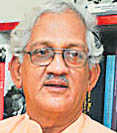New Delhi, Dec. 22: The military has been summoned to flood the country with money. The soldier has been ordered to make and count cash.
A team of 120 Indian Air Force personnel – air warriors – have been deployed at the currency printing press in West Midnapore’s Salboni. Salboni has one of the most prolific currency note presses in the country.
In Madhya Pradesh’s Dewas, too, an army column has been tasked to a Reserve Bank of India currency printing press.
The deployment of the military – rather than the police or paramilitary forces – is indicative of the urgency that the Centre is dealing with in a situation of its own creation: demonetisation of the Rs 500 and the Rs 1,000 notes that were printed before November 8.
Currency soldiers were so far bank staff and air crew.
But now, there is military compulsion at currency printing presses, the Centre has determined. Soldiers have to be physically present at the presses. They are trained to fight. They are not trained to print money. But they have to do “physical labour”.
“Soldiers are coolies today,” one officer admitted. “We do physical labour, but to fight against enemies of the country. Now the government has ordered us to do this,” he said.
The Indian Air Force was drafted into transporting currency notes across the country just about a month ago.
In the twilight of his career, fighter pilot and Air Chief Marshal, Arup Raha, who has just overseen the marriage of his daughter and is fixing himself a retirement home in a township in Calcutta, is carrying out the Great Rupee Airlift.
So far he has had such other paltry stuff – like the depressingly dwindling fighter jet fleet – to bother about.
His successor has just been named: Air Marshal Birender Singh Dhanoa, the current Vice Chief of Air Staff is set to take over.
Dhanoa is also a former director of fighter operations and war-planning. His chief concern now is the deployment of cash.
Unlike in the army, the transition in the IAF is without question. Dhanoa is the seniormost in line to succeed Raha. He is a fighter pilot of distinction, a qualified flying instructor who has done sorties in the MiG21, the Jaguar, the MiG29 and the Sukhoi 30Mki. He has honed a generation of juniors in the skills of air-to-ground attack in high altitudes, like he did in the 1999 Kargil war.
When he moves into Air House in the afternoon of December 31 he, too, will be supervising the Great Rupee Airlift.
The Great Rupee Airlift compares difficulty with the Berlin Airlift of 1948-1949 when the air forces of the UK, US, Canada and France flew supplies to the people of West Berlin after Soviet Forces blockaded the-then divided city. But the Indian Air Force has confirmed to The Telegraph that it has completed more than 100 sorties between November 19, when the Union finance ministry called for its deployment, and December 19.
That is an average of more than three sorties per day – to transport currency notes from four airfields: Ozar (near Nasik), Kalaikunda (near Kharagpur and Salboni), Mysore in Karnataka and Indore (near Dewas) in Madhya Pradesh to more than 10 cities with RBI centres.
The acute shortage of cash led to the Centre directing the Indian Air Force to transport currency notes because chartered aircraft could not or would not do the job.
Repeat sorties have been made to at least six cities – the maximum to Bhopal and after that to Calcutta. These sorties are clubbed into 31 “trips”. Each trip contains within it three sorties – flying the aircraft from their home-bases to the airfields near currency presses, basing them at the airfields or mostly near airfields with maintenance facilities and then flying to and from the destinations where the currency notes are delivered.
An underestimate of the cost of transporting currency notes so far pegs the figure at Rs 65 crore in flying hours. The Indian Air Force has flown nearly 300 hours as currency soldiers.
IAF sources said they fly much faster than the RBI’s presses can print currency notes. Meaning, they are being forced to perform under par.
For the average of more than three sorties a day by the air force’s transport aircraft, plus waiting, many of the aircraft have had to be pulled out of regular duties like couriering soldiers from field stations – such as Leh or Thoise – to peace stations and back. The redeployment of transport aircraft that are in short number because most of them are grounded is stressing the fleet.
A Coordination Cell for the Great Rupee Airlift has been set up in the air chief’s office at Vayusena Bhavan, the air force headquarters in the national capital.
The aircraft assigned to the task are mostly carrying far less weight than they are capable of – an average of 18.4 tonnes only per sortie.
So far the US-sourced strategic airlifter C-17 Globemaster III aircraft – the latest transport planes in the IAF’s inventory – all 10 of which are based in Hindon, east of Delhi, have ferried 218.6 tonnes of currency notes. Each Boeing-made C-17 is capable of a take-off weight of about 30 tonnes. The C-17 is built for short take-offs and landings and inserting special forces and military materiel in hostile environment. The US air force has flown C-17 aircraft non-stop from its own shores to Australia.
The C-17s with the IAF are among other transport aircraft – the (also US-sourced C-130J Hercules and the Soviet-origin Antonov 32) – that are lifting currency notes from four airfields near RBI printing presses at Ozar, Mysore, Kalailunda and Indore.
The maximum number of sorties have been done by the C-130J Hercules (made by Lockheed Martin) aircraft. The 10 aircraft of this kind with the IAF have ferried 323.3 tonnes of currency notes.
The Antonov 32 aircraft, 100 of which are with the IAF, are known to be a workhorse have surprisingly carried out the least number of sorties. That is because the aircraft’s upgrade programme is caught in between the conflict that has hit the military industries of both Russia and Ukraine. Moreover, there is a drop in the confidence on the An-32 since it went missing, presumably into the Bay of Bengal, with 29 passengers and crew on July 22. Most of the An-32 in the fleet of the IAF are grounded.
The workhorse AN-32 aircraft have done only three “trips” so far carrying 10.8 tonnes of currency notes. Each AN-32 can carry 27 tonnes.
The total weight of currency notes ferried by the IAF transport fleet between November 19 and December 19 is 552.7 tonnes.
From Indore, the aircraft are flying notes of denominations of Rs 20, Rs 50 and Rs 100 printed at the RBI press in Dewas. From Mysore and Nasik (Ozar) and Salboni (Kalaikunda), the aircraft are flying notes of Rs 2000 and Rs 500.
The “trips” have been made to Jammu, Calcutta, Guwahati, Ahmedabad, Lucknow, Nagpur, Bombay, Pune, Bhopal, Thiruvananthapuram, Hyderabad, Visakhapatnam and Chennai.
In the North East and in Jammu and Kashmir, the IAF’s helicopters have also flown currency notes to smaller destinations. But that is part of the IAF’s regular tasking.

















































































